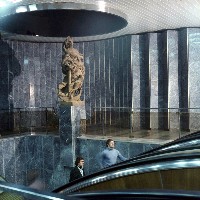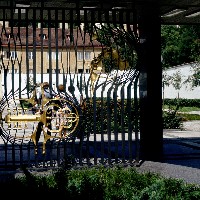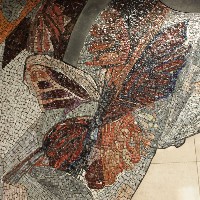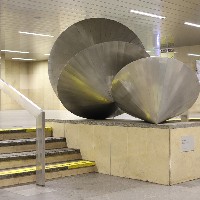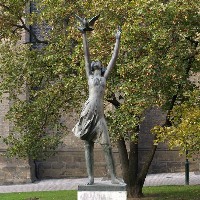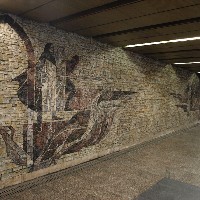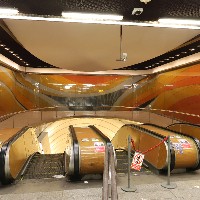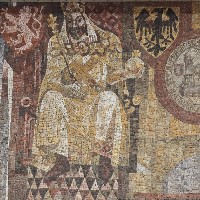Breadcrumbs navigation
The Metro as an Art Gallery
The Metro is undoubtedly the backbone of Prague public transport. Yet it is not just a fast and reliable means of transport, but also an extensive gallery, which hundreds of thousands of people pass through every day. Nevertheless, all too few notice the works of art that can be found here. Why not unlock its gates with the symbolic key off the railings by Malostranská station and head off on an art quest.
During the construction of the first sections of the Prague Metro, between 1966 and 1985, more than a hundred works of art and architectural design found their home on and around its stations. The Metro thus became, in its own way, an exhibition of the art of its time. Prominently featured were artists working with glass and ceramics, although you will also find sculptural works in some of the stations.
Unfortunately, some of these works of art have been destroyed or removed over time. Other works, while remaining in place, are paradoxically distinctive for having been absorbed into commercial spaces where they are not visible at first glance. There are some eighty works in the Metro to be seen to this day, undoubtedly remarkable but neglected architectural, artistic and design works of the former Czechoslovakia. So, come with us on a journey of discovery!
LINE ‘A’
The original route ‘A’ was built between 1973 and 1978, and at that time ran between Dejvická and Náměstí Míru stations. A characteristic element of the stations along this route is the unique aluminium wall cladding, each station in its own colour. Within the station spaces are numerous mosaics and reliefs, but you will also find some interesting objects in their vicinity.
A truly remarkable place, quite possibly one of the most beautiful stations of the Prague metro, is the MALOSTRANSKÁ station at Klárov. The lobby of the station connects with the adjacent garden in front of the Wallenstein Riding School, and copies of Baroque statues by Bernard Braun and Antonín Braun adorn the garden and the station interior. In addition to the statues, you’ll note a fountain and metal ornamental railings, completing this wonderful space. Right next to the station there are two other interesting features – a drinking fountain and a cornerstone.

In some stations, you can really feel the breath of history. One attractive ‘exhibit’, incorporated as part of the vestibule of MŮSTEK station, is the archaeological find of a small bridge that was part of the original Old Town fortifications. There are a whole host of works on historical themes to be found around the Metro, in the stations ŽELIVSKÉHO and JIŘÍHO Z PODĚBRAD.

SOME ART TO LOOK FOR ON LINE ‘A’
SKALKA
- stone mosaic ‘Natural motifs’ (acad. artist Jan Grimm)
- fountain (acad. sculptor Martin Zet)
ŽELIVSKÉHO
- bronze relief ‘Hussite allegory’ (acad. sculptor Jan Simota)
- stone mosaic ‘Jan Želivský and his time’ (acad. artist Jiřina Adamcová)
- fountain ‘Chalice’ (acad. sculptor František Pašek)
FLORA
- ceramic reliefs ‘Plant motifs’ (acad. sculptor Petr Svoboda)
JIŘÍHO Z PODĚBRAD
- stone relief ‘George of Poděbrady’ (acad. sculptor Jiří Dušek)
- ceramic reliefs ‘Hussite Prague’ (acad. sculptor Lubomir Šilar)
- fountain ‘Unified Europe’ (acad. sculptor Petr Šedivý)
NÁMĚSTÍ MÍRU
- bronze statue ‘Peace allegory’ (acad. sculptor Jan Kryštfek)
MUZEUM
- busts of Vladimír List and Bohumil Belada, authors of the 1926 Prague Metro design (acad. sculptor Josef Kadlčík, acad. sculptor Jan Bartoš)
MŮSTEK
- historical bridge arch, part of the original fortifications of the Old Town (restorers Aloisie Viškovská, Václav Hlavatý, Miroslav Vajchr, Josef Vitvar)
- wall reliefs (Ladislav Dydek, František Bílek)
MALOSTRANSKÁ
- copies of Baroque statues by M. B. Braun and A. Braun in the vestibule and garden (restorers Aloisie Viškovská, Václav Hlavatý, Miroslav Vajchr, Josef Vitvar)
- metal railings in the entrance and garden (acad. sculptor Jan Smrž, acad. sculptor Vojtěch Kobylka, acad. sculptor Eduard Řepka, acad. sculptor Jaromír Brudhaus, acad. sculptor Zbyněk Runczik)
- fountain in front of the Wallenstein Riding School (ing. architect Zdeněk Drobný, Ladislav Jiránek)
- drinking fountain (acad. sculptor Miroslav Vystrčil)
- cornerstone (acad. sculptor Lubomir Růžička)
HRADČANSKÁ
- stone relief with crown (medallion designer Jiří Prádler)
DEJVICKÁ
- stone relief ‘Dynamics of the Revolution’ (acad. artist Martin Sladký)
LINE ‘B’
The first section of the ‘B’ route was built between 1979 and 1985, connecting the stations between Smíchov and Florenc. In 1988 the line was extended to Nové Butovice. The dominant aesthetic elements here are glass tiles on the walls behind the rails, and on the pillars. The station premises are decorated with reliefs, vitrages and mosaics.
If you decide to explore the KARLOVO NÁMĚSTÍ station, you will surely feast your eyes. In the Palackého náměstí vestibule are two interesting works in glass – a vitrage in the upper space of the escalators and an interesting circular glass object. You should also not miss the drinking fountain in the nearby Zítkovy sady. The second vestibule is dominated by a large mosaic called ‘Charles IV and his time’, which is themed to match the name of the station.

One of the most striking works on this metro line is the art installation ‘Gears’, located in the PALMOVKA station vestibule. It is a steel sculpture depicting three metal gears, to symbolize the industrial character of Libeň district. INVALIDOVNA station boasts a brightly coloured vitrage on Sport, with a nod to the unsuccessful bid to hold the Summer Olympics near Invalidovna in 1980. If you go all the way to NOVÉ BUTOVICE station, you can’t miss the sandstone sculpture called ‘Monument to Dukla heroes’ referencing the original name of the station “Dukelská”, which was also the terminus until 1994.

SOME ART TO LOOK FOR ON LINE ‘B’
PALMOVKA
- steel sculpture ‘Gears’ (acad. sculptor Alexius Appl)
INVALIDOVNA
- vitrage ‘Sport’ (acad. artist Eva Hermanská)
- ceramic sculptures (acad. artist Lydia Hladíková, ceramic artists Děvana Mírová and Marie Rychlíková)
MŮSTEK
- arrow ceramic relief (acad. sculptor Helena Samohelová)
- ceramic relief wall Prague (acad. sculptor Lubomir Šilar)
- fountains on Jungmannovo náměstí square (acad. sculptor Jiří Kryštfek) and at Na Příkopě street (ing. arch. Karel Fořtl, ing. arch. Miroslav Suchý)
KARLOVO NÁMĚSTÍ
- vitrage glass wall (acad. sculptor Jaroslav Štursa)
- drinking fountain in Zítkovy sady (acad. sculptor Luboš Růžička)
- mosaic ‘Charles IV and his time’ (acad. artist Radomír Kolář, František Tesař)
- cladding made of glass blocks (acad. sculptor František Vízner)
ANDĚL
- bronze reliefs on the platform
RADLICKÁ
- glass mosaic (acad. sculptor Alexius Appl)
- granite-bronze sculpture ‘The relationship of nature and technology’ (acad. architect Zdeněk Hošek)
NOVÉ BUTOVICE
- sandstone sculpture ‘Dukla’ (acad. sculptor Milan Vácha)
LINE ‘C’
The first part of route ‘C’, the oldest section of the Prague Metro, which connected Florenc and Kačerov stations, was built between 1966 and 1974, and in 1980 was extended to Háje, four years later to Nádraží Holešovice. The station is clad in marble, mostly white and grey. The dominant aesthetic element here are ceramic bricks, which we find in all stations, variously combined, shaped and coloured.
VLTAVSKÁ station has become one of the most popular places for graffiti sprayers, covering the surroundings too. Still, you shouldn’t just walk through this station heedlessly. The underground part of the vestibule is lined with very interestingly shaped ceramics, in the vestibule itself is a circular vitrage of the Vltava River, while the space in front of the station is home to a ceramic fountain ‘The Faun and Vltava’ (period photo, © Ondřej Surový). Prague City Gallery in cooperation with the Prague Municipal Transport Company launched an outdoor gallery project this year that allows particular underused and forgotten spaces of the retaining walls at the Vltavská metro station for some cultural revival, with short-term installations.

NÁDRAŽÍ HOLEŠOVICE station is quite similar to the neighbouring Vltavská station. The dominant element here are tiles in the form of ceramic strips, which are arranged in spaced clusters. At the station we can also find a set of sculptures called ‘The River’ created by a combination of Nehodivy [predominantly grey] marble and pebbles. VYŠEHRAD station is one-of-a-kind, quite unlike the rest of the stations along the route. It is not located underground, but on the surface, and its glass walls allow passengers to enjoy a panorama of Prague so impressive that it completely distracts from any architectural elements in the station. Compared to other stations on this section of the metro, the KAČEROV station is very artistically oriented. The vestibule is dominated by a relief carved into Hořice sandstone, [pale ochre veined with iron-ore] while near the ticket machines there are glass vitrages with fascinating left-handed spiral motifs. The atrium in front of the station invites you to sit and relax by a fountain.

SOME ART TO LOOK FOR ON LINE ‘C’
NÁDRAŽÍ HOLEŠOVICE
- set of marble sculptures ‘The River’ (acad. sculptor Josef Klimeš)
VLTAVSKÁ
- ceramic fountain ‘The Faun and Vltava’ (acad. sculptor Olga Hudečková, acad. sculptor Miroslav Hudeček)
- circular vitrage ‘Vltava’ (Jan Fišera, Václav Zajíc)
- shaped ceramic vestibule panelling (Vladimír Dolejš)
FLORENC
- stone mosaic ‘Battle of Sokolovo’ (acad. artist Oldřich Oplt, Italian artist Sauro Ballardini)
MUZEUM
- busts of Vladimír List and Bohumil Belada, authors of the 1926 Prague Metro design (acad. sculptor Josef Kadlčík, acad. sculptor Jan Bartoš)
I. P. PAVLOVA
- stone relief of lions from the original Marian walls (restorers Aloisie Viškovská, Václav Hlavatý, Miroslav Vajchr, Josef Vitvar)
PRAŽSKÉHO POVSTÁNÍ
- stone sculpture ‘Barricade – May 1945’ (acad. sculptor Stanislav Hanzik)
KAČEROV
- sandstone relief with natural motifs (acad. sculptor Vladislav Gajda)
- glass vitrages with left-handed spiral motif (Benjamin Hejlek)
- fountain (acad. sculptor Jiří Kryštfek)
CHODOV
- bronze ‘Metro builder’ statue (acad. sculptor František Radvan)
HÁJE
- stone mosaic ‘Cosmonauts’ (acad. artist Alois Fišárek)
- bronze figural pair ‘Cosmonauts’ (acad. sculptor Jan Bartoš)
SOURCES USED:
- Prague Municipal Transport Co.
- Prague City Gallery, photo © Ondřej Surový 2021
- www.metroart.cz
- Wikipedia
